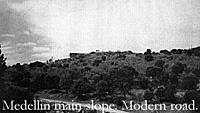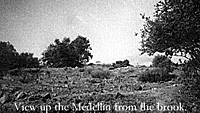
As was the usual French practice, the opening of the battle was signalled by a cannonade of the Medellin by 50 or 60 guns. Its purpose was to soften up the opposition before the assault went in. Wellesley had adopted his by now usual practice of ordering his men to lie down behind the crest of the hill so the effect of the bombardment was greatly reduced. British artillery, although fewer in number, replied. The two hills were soon enveloped in smoke, which hid the British positions. Wellesley's view of the battlefield was also obscured but the noises coming up from the valley informed him that his skirmishers were being heavily engaged. Before the cannonade had started he had been able to see almost all of the French army drawn up ready to attack his positions. What were the French up to?
The French had discovered, from Spanish prisoners taken the night before, the position of the heavily defended line held by Cuesta's troops. They decided to screen these with Milhaud's Dragoons. The majonty of their force and all their attacks would be against the British positions. The Spanish force of 30,000 became a fixed flank guard for the 20,000 British who faced some 40,000 French. Wellesley was facing odds of almost 2 to 1.
The first French attack of the day was a repeat of the night before. Once more Ruffin's division, now down to about 4,300 men, split into three columns of three battalions each.
Why advance in a column? A column is the most efficient way of getting formed bodies of men across a battlefield and still retain some form of order when they reach the point of fighting. If men are formed into line facing the enemy, and then marched a long distance across a rough field they will soon lose all semblance of order. The troops will arrive at the enemy piecemeal and will be easily repulsed, probably with heavy losses. So column tactics had been developed with many variations to the column formation that could be adopted depending on the circumstances.
 The French had learnt some lessons from their contact with British lines at Vimeiro. This time they came on in 'column of division', that is on a front of two companies instead of a single company as at Vimeiro. Thus they doubled the muskets that were initially available tbr combat. They would have about 60 men in the front rank and have approximately 24 ranks,
making a column of just under 1,500 men. If we say that at best only the first three rows of the column could fire then only 180 of those men could take part in active combat.
The rest reinforced the front rows and gave moral support
and added weight to the forward momentum of the column.
They also offered a tempting target for the opposition's
artillery and any long range volleys aimed their way.
The French had learnt some lessons from their contact with British lines at Vimeiro. This time they came on in 'column of division', that is on a front of two companies instead of a single company as at Vimeiro. Thus they doubled the muskets that were initially available tbr combat. They would have about 60 men in the front rank and have approximately 24 ranks,
making a column of just under 1,500 men. If we say that at best only the first three rows of the column could fire then only 180 of those men could take part in active combat.
The rest reinforced the front rows and gave moral support
and added weight to the forward momentum of the column.
They also offered a tempting target for the opposition's
artillery and any long range volleys aimed their way.
The French answer to this was two-fold. First, their large calibre artillery used counter-battery fire to silence the opposition guns before the column came within eftective range. They also sent forward small calibre guns to help soften up the enemy line.
Secondly, some troops formed a force of skirmishers in front of the columns. It was their job to harass the enemy line, pick off officers and NCO's, thus cutting the chain of command. Silencing the drummers and buglers who were the opposition battalions' communications system was also high on their list of targets.
A wary eye had also to be kept open for a surprise cavalry attack. An oblong column was a better formation for detending itself against horsemen than a thin fragile line, which would take longer to form a detensive square. However it was not just a case of marching a column up to a line and forcing your way through, that did happen on occasion, though not when they met a British line.
The idea was for the column to deploy into line just before it came within effective musket range, say 200 to 150 yards. Then march up to the enemy and somewhere between 100 to 50 yards fire a controlled volley using all the battalions' muskets. The artillery would have softened up the enemy line and after a volley or two a threatened bayonet charge had so far seen off the best Europe could offer.
Unfortunately for the French, when they met the British they had great difficulty finding the enemy line. Wellesley had invariably sheltered his men behind a crest or fold in the ground. What they did find was an opposition force of skirmishers who did an excellent job of harassing them. Occasionally this skirmish line was so thick that it was mistaken for the main line.
Some of the British, but by no means all, were also better armed for this type of work with the Baker rifle. It was a deadly weapon in the hands of a trained rifleman as it had a longer range and was much more accurate than a musket. It did however take longer to load. Officers within the French column would be cut down, NCO's trying to maintain the formation would be picked off and the drummers' marching beat silenced.
What the French skirmishers were supposed to be doing to the enemy was very effectively being done to them. Those French commanders left standing would be in a quandary. They would be suffering extreme harassment from skirmishers and the main British line was hidden behind the hill crest. Where and when should they maneuver from column into line?
It was a problem they would have time and again all the way to Waterloo. It was the clash between the two groups of skirmishers in the smoke enshrouded valley between the Medellin and Cascajal that Wellesley would hear at his post up on the hill.
 One of the French columns headed just to the
north of the Medellin into the open plain. This force
comprised the battalions that had done most of the hard
fighting the night before. They may have been deliberately
given an easier task or decided to take an easier route to a
safer position.
One of the French columns headed just to the
north of the Medellin into the open plain. This force
comprised the battalions that had done most of the hard
fighting the night before. They may have been deliberately
given an easier task or decided to take an easier route to a
safer position.
They exchanged a few long range volleys with the 29th but generally kept well out of harm's way. The other two columns aimed at the centre and right of Stewarts's brigade. The British skirmishers down in the valley had the advantage over their French counter parts in numbers, equipment and position. The fighting grew louder, the noise increasing when the extra weight of the French columns engaged the British, eventually forcing them up the hill.
The British light infantry retired as they had been taught to do; one man fired while his partner covered him. When he had reloaded and could give cover the other man selected his target, aimed and fired. This was repeated as they moved slowly up the hill. They moved so slowly that General Hill, impatient to move his own troops forward, was heard to swear for the
first of only two occasions in the Peninsular. 'Damn their firing, let them come in anyhow.' [15] Finally the skirmishers were through the British formation, Hill brought his men over the crest in line and the bloody work began.
No longer would the French be wondering when they should have deployed into line, it was too late now. Column versus line and the mathematics of deployable muskets took over. A French column could fire 180 maybe 200 muskets, with two columns that gave them at
most 400.
With the 29th partly engaged with the northern column Steward could only deploy 1,500
muskets. These would have to be split between the centre column and the southern column marching towards Stewart's right. The southern column at first faired better. It was aiming at the junction between Stewart's right and the left of Hill's other brigade under Tilson. This gave it a tactical advantage because if it could breach the gap then it could wheel and take
either or both British lines en flank.
It would be a very dangerous moment for the British.
Taken en flank they could be rolled up and overwhelmed.
The French southern column advanced slowly but made
progress. Steward could only spare 300 men to counter
this attack, but part of Tilson's brigade joined in and
between them they started to wrap around the head of the
column. Slowly it was being ground to a halt. Then some
light infantry from Lowe's brigade joined in on the
column's southern flank. The biter had been bitten. The
French had been taken en flank.
The centre French column had meanwhile come
up to the centre right of Stewart's brigade and at a range of
about 90 yards received the first volley from 1200
muskets. The 200 muskets replied but the contest was
unequal. To compound the problem they tried to deploy
into line. As more British volleys ploughed into the mass
of reeling men, confusion reigned. Both French
columns struggled to regain their order, those men at the
front firing and receiving volleys, whilst those behind
pushed forward. Amid the smoke, noise and confusion the
rear ranks could not see what was happening at the front
of the column, but they could guess.
At some point, and who can tell what makes it happen sometimes but not every time, someone turned around and pushed towards the back. It generally happens at the rear of the column; perhaps those at the front are too busy coping with what's happening around them to think
of escape. Others turned and the movement backwards had begun that would soon change into a running retreat. Both columns broke like this within minutes of each other. The British pursued them down the hill killing some and capturing others. They crossed the Portina Brooke but sensibly retreated when faced with fresh enemy troops.
Both sides paused to regain their breath. The artillery continued to fire for an hour or so but by 8 a.m. the guns had stopped and a quiet calm descended. Quiet that is except for the moans and cries of the wounded covering the hillside. The day was hot and both sides were desperate for water. French and British troops exhibited that camaraderie under common danger that marked the relationship between the two forces. Unofficially they refrained from fighting whilst both sides drank what they could from the murky waters of the Portina brook. The British also hastily buried their dead. At 11a.m. a bugle sounded and the French returned to their positions to prepare for another attack.
Back to Table of Contents -- First Empire 26 This article appears in MagWeb (Magazine Web) on the Internet World Wide Web.
© Copyright 1996 by First Empire.
Other military history articles and gaming articles are available at http://www.magweb.com